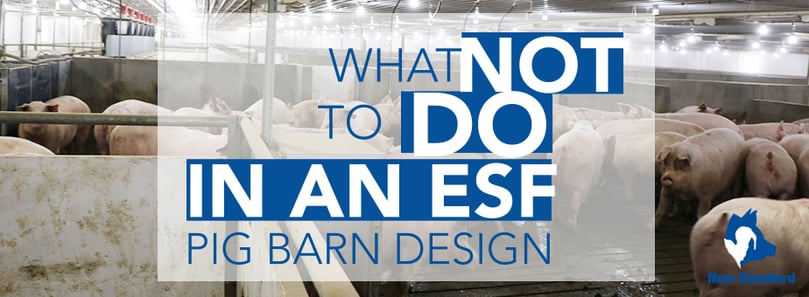
Putting together a pig barn design is a long and detailed process for you as a producer. You have to weigh your different housing options and how each will affect your production. If you decide to build a barn with Electronic Sow Feeding equipment, it is important to know how the design of your system will affect your animals, your barn staff, and your everyday operations. Proper ESF design will improve efficiency and production while a poor pig barn design will result in a disastrous investment.
Over the years, as we continuously advance production automation, we have seen things that simply do not work. Here are a few things we have found are better to avoid in an ESF hog barn design:
Install Identification Sensors At the ESF Station Entrance
There are systems out there that have an antenna at the entrance of the feed station and will only let in sows that have feed ration available. While this seems like a logical place to identify the sows, it ends up being a disaster. Identifying each pig at the ESF entrance will work for the first few pigs, but everything will go awry if any sows make their way back to the entrance after eating. Because they have already received their feed, the gates will not open for them. Rather than walking away from the station, the more dominant sows will block the entrance of the station, barring any sows that have not eaten from entering the station. This creates a dam effect, and your barn staff will have to constantly move these sows from the entrances of the stations.
If you choose a feed station with the antenna at the feed trough inside the entrance gates, you will avoid this problem. The gates will always let a sow through, even if she has already eaten. She just will not receive any feed once she is inside. She cannot block the dispenser once she is inside because she cannot turn around. The stations should be narrow enough to not allow any pig to change directions. When the gate is unlocked to let the next sow in, she will nudge the sow in front of her out of the way, even if the front sow is more dominant. Since she cannot defend herself and is uncomfortable with the nudging, she is forced to walk forward and exit the station.
Include Swinging Troughs in Your ESF Stations
There are some station manufacturers that use a movable trough that will swing out in front of the sow or gilt when she enters the station and has a feed ration available. The feed troughs might have the feed ration dispense in one total amount or it may be dispensed over a set time period. The problems with a swinging trough manifest themselves in extra maintenance and leftover feed if a sow doesn’t eat everything at once. Most importantly, the small crevasses that will invariably be in a system like this are going to be prone to feed build up that cannot be properly cleaned. This feed will quickly become moldy and create health issues for the girls who must eat there.
Add Baffles to Your Feed Dispenser
Baffles have been added to feed troughs on some stations as a way to prevent a sow who has already eaten all of her ration from getting her head back into the feed trough when she re-enters the station a second, third or fourth time. These baffles are typically applied to cope with or address other issues that arise. They may be used to increase feed dispensing rates and move animals out of the stations more quickly. This will invariably force some sows out before they have eaten everything. The trough baffle is used to get her out sooner and to prevent the girl who has eaten everything already from licking up whatever she didn’t eat. Of course, most sows don’t accept this type of forced behavior and will fight the baffles unceasingly.
Why add more maintenance time and chance of equipment failure with your pig barn design? By adding baffles to your feed dispensers, we have found that you add more stress to both your barn staff and the pigs. When they malfunction (sows will break them), they will shut your station down causing you to drop everything to get it back up and running. Shutting one of your stations down will also force more sows to your other stations and can cause more competition and more stress.
Force Too Many Sows Onto One Station
It's natural to want to fit as many sows on an Electronic Sow Feeding station as possible. After all, an ESF station can be a significant capital investment. The numbers show however that this will not pay off. Your throughput on each feed station will increase but not enough to offset the reduced production. Rather than focusing on the number of sows on each ESF station, we should focus on the number of piglets produced from each station. You will reach a point when adding more sows to a station results in fewer live born piglets per sow. The added competition and stress of having more sows on one station will take its toll on your herd and your production numbers and profit margins will drop. We have found that while the number of sows per station varies greatly in the industry, there is little variance in the number of piglets produced from each station.
Simply put, when putting together a pig barn design the goal should be to increase profits and improve efficiency rather than cut costs.





